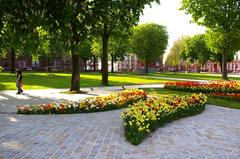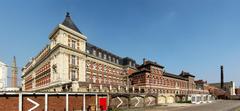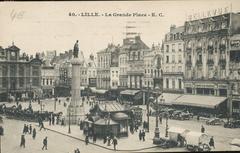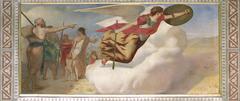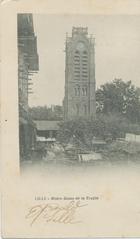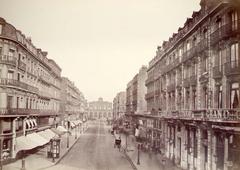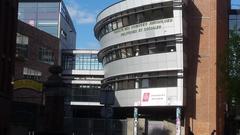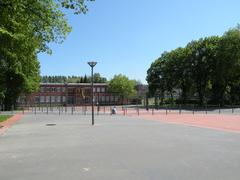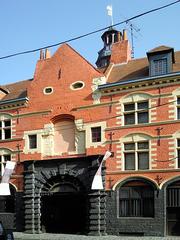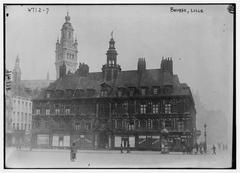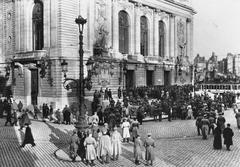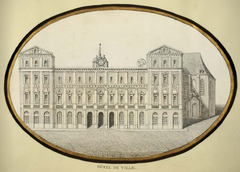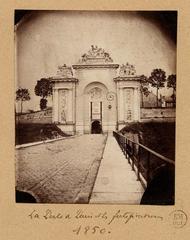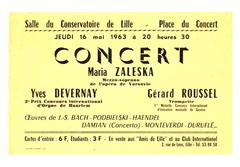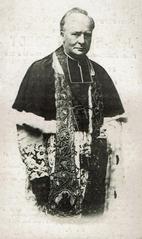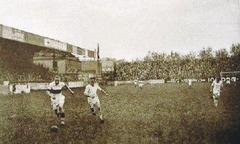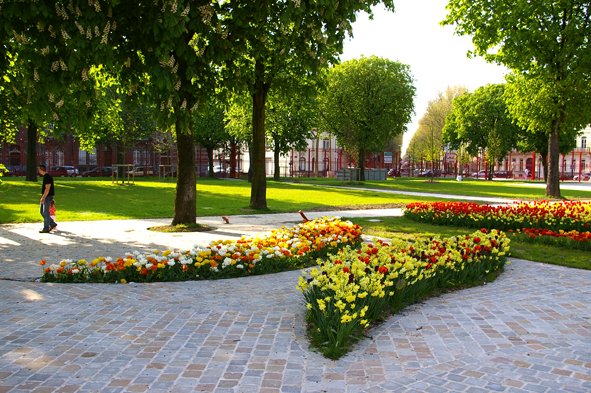
Comprehensive Guide to Visiting Parc Jean-Baptiste Lebas, Lille, France
Date: 18/07/2024
Introduction
Parc Jean-Baptiste Lebas, situated in the heart of Lille, France, is a historical and cultural gem that serves as a green sanctuary within the bustling city. Named after Jean-Baptiste Lebas, a prominent socialist politician and member of the French Resistance during World War II, the park is a tribute to his enduring legacy and contributions to Lille. Established in the early 20th century, the park has evolved from military fortifications to a beloved public space, reflecting the city’s dynamic history and commitment to urban development (Lille Tourism).
Designed by renowned landscape architect Édouard André, Parc Jean-Baptiste Lebas incorporates the French formal garden style with elements like a central promenade, ornamental fountains, statues, and a large pond. These features create a picturesque environment, making it a perfect retreat for nature lovers, history enthusiasts, and casual visitors alike. The park also plays a vital role in the cultural life of Lille, hosting numerous events such as music festivals, art exhibitions, and community gatherings throughout the year (Lille City Guide).
With no admission fee and accessible pathways, the park is open year-round, welcoming both locals and tourists to explore its rich history and enjoy its various amenities. Visitors can also take advantage of guided tours that offer deeper insights into the park’s historical and architectural significance. Located near other major attractions like the Palais des Beaux-Arts and the Citadel of Lille, Parc Jean-Baptiste Lebas is an essential stop for anyone looking to experience the cultural and historical richness of Lille (Tourism Lille).
Table of Contents
- [Introduction](#introductionintroduction)
- [History and Features](#history-and-featureshistory-and-features)
- [Origins and Early Development](#origins-and-early-developmentorigins-and-early-development)
- [Design and Architectural Features](#design-and-architectural-featuresdesign-and-architectural-features)
- [World War II and Post-War Era](#world-war-ii-and-post-war-eraworld-war-ii-and-post-war-era)
- [Modern Developments and Renovations](#modern-developments-and-renovationsmodern-developments-and-renovations)
- [Cultural and Social Significance](#cultural-and-social-significancecultural-and-social-significance)
- [Visitor Information](#visitor-informationvisitor-information)
- [Ticket Prices and Visiting Hours](#ticket-prices-and-visiting-hoursticket-prices-and-visiting-hours)
- [Accessibility and Travel Tips](#accessibility-and-travel-tipsaccessibility-and-travel-tips)
- [Nearby Attractions](#nearby-attractionsnearby-attractions)
- [Special Features](#special-featuresspecial-features)
- [Guided Tours](#guided-toursguided-tours)
- [Photographic Spots](#photographic-spotsphotographic-spots)
- [Special Events](#special-eventsspecial-events)
- [Conclusion](#conclusionconclusion)
- [FAQ](#faqfaq)
- [Call to Action](#call-to-actioncall-to-action)
- [Visuals](#visualsvisuals)
- [Internal and External Links](#internal-and-external-linksinternal-and-external-links)
History and Features
Origins and Early Development
Parc Jean-Baptiste Lebas dates back to the early 20th century and is named after Jean-Baptiste Lebas, a prominent socialist politician and a member of the French Resistance during World War II. Originally, the land was part of the military fortifications surrounding Lille, which were dismantled as the city expanded and modernized. The transformation of this military land into a public park was part of a broader urban development plan aimed at improving the quality of life for Lille’s residents.
Design and Architectural Features
Renowned landscape architect Édouard André designed Parc Jean-Baptiste Lebas, incorporating elements of the French formal garden style. The park features a central promenade lined with rows of trees and benches, ornamental fountains, statues, and a large pond, creating a picturesque and relaxing environment for visitors.
World War II and Post-War Era
During World War II, the park suffered damage from bombings and was used by the occupying German forces. Despite these challenges, it remained a symbol of resilience for the people of Lille. After the war, efforts were made to restore the park, adding new playgrounds, sports fields, and recreational areas to cater to the needs of the growing population.
Modern Developments and Renovations
In the early 2000s, significant renovations were undertaken to modernize the park while retaining its historical charm. These renovations included the restoration of the central promenade, new lighting and seating installations, and the creation of additional green spaces. Sustainability and environmental conservation were also prioritized, with efforts to enhance biodiversity and introduce eco-friendly practices.
Cultural and Social Significance
Parc Jean-Baptiste Lebas is not just a recreational space but also a cultural and social hub. It hosts numerous events throughout the year, including music festivals, art exhibitions, and community gatherings, contributing to Lille’s vibrant cultural scene. The park’s historical significance and picturesque landscapes make it a popular destination for both locals and tourists.
Visitor Information
Ticket Prices and Visiting Hours
Parc Jean-Baptiste Lebas is open to the public year-round, with no admission fee. The park’s opening hours are from 7:00 AM to 8:00 PM during the summer months and from 8:00 AM to 6:00 PM in winter. For the most up-to-date information on visiting hours, please check the official Lille tourism website.
Accessibility and Travel Tips
The park is easily accessible by public transportation, with several bus and tram lines stopping nearby. It is also within walking distance from Lille’s city center. The park is wheelchair accessible, with paved pathways and ample seating areas. Visitors are encouraged to wear comfortable shoes and bring water, especially during the warmer months.
Nearby Attractions
While visiting Parc Jean-Baptiste Lebas, you can also explore other nearby historical sites in Lille, such as the Palais des Beaux-Arts, La Vieille Bourse, and the Citadel of Lille. These attractions offer a deeper insight into the city’s rich history and cultural heritage.
Special Features
Guided Tours
Guided tours of Parc Jean-Baptiste Lebas are available, providing visitors with an in-depth understanding of the park’s history, design, and significance. These tours can be booked through the official Lille tourism website or at the park’s information center.
Photographic Spots
The park offers numerous picturesque spots perfect for photography, including the central promenade, ornamental fountains, and the large pond. These locations provide beautiful backdrops for capturing memorable moments.
Special Events
Throughout the year, Parc Jean-Baptiste Lebas hosts various special events, such as seasonal festivals, cultural exhibitions, and community gatherings. These events are a great way to experience the local culture and engage with the community.
Conclusion
Parc Jean-Baptiste Lebas stands as a testament to Lille’s rich historical tapestry and commitment to providing green, cultural spaces for its residents and visitors. From its origins as part of the city’s military fortifications to its current status as a vibrant urban park, it has continually adapted and evolved, reflecting the resilience and spirit of Lille. The park’s blend of historical significance, architectural beauty, and diverse recreational opportunities make it a unique and enriching destination for all.
Whether you’re taking a leisurely stroll down the tree-lined promenades, enjoying a family picnic on the expansive lawns, or participating in one of the many community events, Parc Jean-Baptiste Lebas offers a multifaceted experience that caters to a wide range of interests. Its accessibility, free admission, and proximity to other notable attractions further enhance its appeal, making it a must-visit location in Lille (Lille Education).
As the park continues to develop and embrace sustainable practices, it remains a vital ecological asset and a hub for cultural and social activities. Future plans for expansion and modernization promise to keep Parc Jean-Baptiste Lebas at the forefront of urban park design, ensuring it remains a cherished landmark for generations to come (EcoLille). For those seeking to explore the essence of Lille, a visit to Parc Jean-Baptiste Lebas is undoubtedly a rewarding and memorable experience.
FAQ
What are the visiting hours for Parc Jean-Baptiste Lebas?
- The park is open from 7:00 AM to 8:00 PM during the summer months and from 8:00 AM to 6:00 PM in winter. Please check the official Lille tourism website for the most up-to-date information.
Is there an admission fee for Parc Jean-Baptiste Lebas?
- No, the park is free to enter and open to the public year-round.
Are guided tours available?
- Yes, guided tours are available and can be booked through the official Lille tourism website or at the park’s information center.
What nearby attractions can I visit?
- Nearby attractions include the Palais des Beaux-Arts, La Vieille Bourse, and the Citadel of Lille, all offering a deeper insight into Lille’s rich history and cultural heritage.
Call to Action
To stay updated on events and news related to Parc Jean-Baptiste Lebas, download the Audiala mobile app, check out other related posts, or follow us on social media for more updates. For more information, visit the official Lille tourism website.
Visuals
Alt text: Central promenade of Parc Jean-Baptiste Lebas with rows of trees and benches
Alt text: Ornamental fountain in Parc Jean-Baptiste Lebas
Alt text: Large pond in Parc Jean-Baptiste Lebas
Internal and External Links
References
- Lille Tourism, 2024, Lille Tourism lilletourism
- Lille City Guide, 2024, Lille City Guide lillecityguide
- Tourism Lille, 2024, Tourism Lille tourismlille
- Lille Education, 2024, Lille Education lilleeducation
- EcoLille, 2024, EcoLille ecolille
